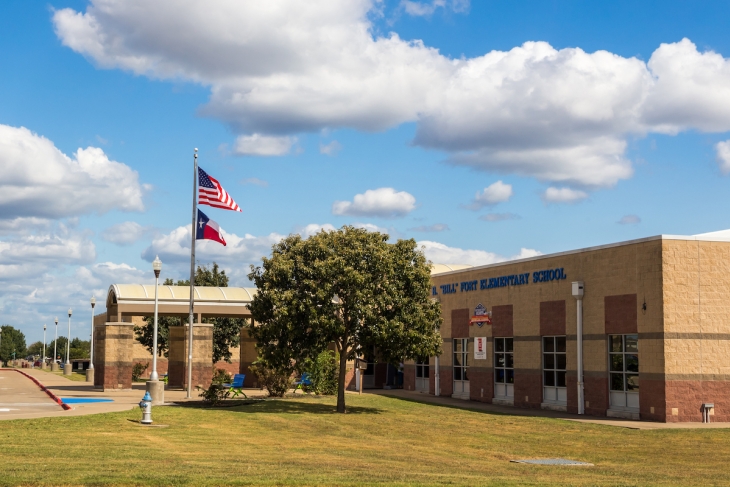A good case can be made that, to the degree K–12 education in the U.S. has embraced high-quality instructional materials (HQIM), the movement began just over a decade ago with EngageNY.
Launched in 2011 with $700 million in federal “Race to the Top” funding to support the implementation of the Common Core State Standards, EngageNY provided a comprehensive suite of free, downloadable instructional materials in English language arts and math. It also demonstrated convincingly that districts, schools, and teachers across the country were starved for quality curriculum: Its resources became even more widely used outside the Empire State than by the teachers for whom it was built. A 2015 RAND survey found that one in four English teachers nationwide were using EngageNY. Uptake for math teachers was even higher. The vast majority of teachers surveyed reported their districts either required or recommended that they use it.
New York State stopped supporting EngageNY two years ago. But a new open educational resource has just debuted that has the potential to pick up where it left off. The Texas Education Agency has spent three years piloting a promising set of ELA materials, which became freely available late last month: a structured and sequenced, knowledge- and vocabulary-rich curriculum for kindergarten through fifth grade, including reading materials, teacher’s guides, activity books, and supporting resources—all online, all downloadable, all free to anybody who wants to use it.
That said, if you’ve heard anything at all about this initiative, it’s probably that Texas is trying to “inject Bible stories” into its elementary school classrooms. When The 74 broke news of the project, its headline said the Texas initiative “raises questions about ‘religious and ideological agendas.’” A report in the Washington Post this week said “it is clear the materials include many religious references that center Christianity.” This framing is unfortunate and frustrating. Unfortunate because it’s distracted attention from the fact that Texas seems to well and truly understand the ingredients of language proficiency. And frustrating because, if your takeaway is that the curriculum doesn’t grant “equal time” to other religions (as one Texas state lawmaker put it), you’re not seeing language proficiency for what it is and how it works. And this understanding is particularly important for low-income students.
To state it bluntly, “equity” is not bean-counting, it’s literacy. Speakers and writers make assumptions about what listeners and readers know. Not just vocabulary, but a vast array of literary and historical allusions and idioms, including Biblical references—Pandora’s box, a pound of flesh, Prodigal Son, Good Samaritan, David and Goliath, forbidden fruit, white whale, to name but a few. These and countless other examples act as a kind of shorthand for complex ideas and concepts. They color our language and, most pertinently, they are broadly shared bits of common knowledge that literate people simply drop into their discourse without any explanation whatsoever. Those who get these references are language-haves; those who don’t are language have-nots and will always be at a verbal disadvantage. Not for nothing did E.D. Hirsch, Jr. title his first and most famous book Cultural Literacy. It refers to the ability to understand and use the information and references that are common in a culture. For decades, Hirsch has passionately and unimpeachably argued that possession of this shared body of knowledge is crucial to reading comprehension, effective communication, social inclusion, and citizenship.
Seen through this lens, designing an effective curriculum isn’t an exercise in canon-making (“learn this because I said so!”). It’s a curatorial effort: Learn this because literate speakers and writers assume you know it and you’ll be at an enormous disadvantage if you don’t. Every effort must be made to ensure that students, particularly disadvantaged students and English learners are conversant in literature, history, science, the arts, and yes, the Bible—the robust array of mental furniture that their well-off peers take for granted, and upon which mature language proficiency depends. Equity, properly understood, demands nothing less. Hirsch himself said it best: “Public education has no more right to continue to foster segregated knowledge than it has to foster segregated schools.”
This was clearly on the mind of Texas leaders, including Commissioner of Education Mike Morath, who previewed the state’s new OER curriculum for me last month. “Clearly, you have to have a very skilled principal and skilled teachers. But there’s an aspect of curriculum design that’s critical in order for reading comprehension to grow,” he explained. “You have to have explicit, systematic direct instruction in phonics. You have to have vocabulary complexity. You have to have knowledge coherence as opposed to skill coherence in the design of your units and lessons. And you have to write a lot in response to reading.” Hear, hear.
Echoing previous studies that have shown that disadvantaged students tend to get low-rigor, unchallenging schoolwork, Morath said the Texas Education Agency replicated TNTP’s well-known “Opportunity Myth” study in twenty-seven Texas school districts and found that, “in elementary school reading, only 19 percent of the assignments we sampled were on grade level.” This sets in motion a cycle of underperformance, he noted, “because teachers aren’t deliberately doing this.” Kids, too, might not realize they’re working diligently but on material that’s below grade level. “Then the state assessment comes around and says you’re not performing at grade level. And everybody’s like, ‘What gives?’”
Close observers of curriculum will recognize that the Texas “OER” (open educational resource) is an adaptation of the well-regarded Core Knowledge Language Arts curriculum, which a Texas Education Agency spokesperson confirmed was “purchased as a foundational product and then overhauled based on feedback to align to Texas state standards, research-based instructional practices, and recommendations from the field.” With 9,000 campuses, 4,500 elementary schools, and 400,000 teachers, “no one should expect a miracle overnight,” Morath said. “But we’re moving in a very evidence-based direction in Texas.” Initial results from districts that have piloted the curriculum, he added, are “not universal, but promising.” The majority Hispanic and low-income Temple Independent School District in Central Texas, for example, has seen a 13 percent jump in third graders meeting standards compared to pre-Covid levels. Results were even stronger in Lubbock, which has similar demographics and saw a 21 percent rise in African American third graders meeting standards, and 19 percent of Hispanics in its first year of implementation. “It’s not just the rising tide is lifting all ships. We have some evidence base that this disproportionately lifts the ships of kids who have been the most academically at risk,” Morath observed.
As for the Bible stories controversy, Morath said via email this week, “We are actively taking feedback on the product and will make updates to address any errors that are surfaced to ensure that references to any religious tradition(s) are done accurately and reinforce the intended purposes of bolstering understanding of literature, history, and culture.” It would be lamentable, however, if that controversy derailed or neutered a project that has the potential to benefit students nationwide, further the HQIM movement, and advance the field’s sophistication on what language proficiency requires.
It’s commonly observed that a dictionary isn’t a rule book, it’s a history book. It doesn’t tell you how words must be used, only how they have been used. The same basic idea runs throughout language at large: You can’t control or impose your will on it. But you can teach it. This is the Achilles’ heel (see what I did there?) of those who think they’re striking a blow for social justice by “decolonizing” curriculum or whose view of equity is limited to mere “inclusion.” They are at grave risk of imposing a kind of illiteracy on disadvantaged children by denying them access to knowledge and vocabulary that is essential for mature language proficiency.
The bottom line: If you think Bible stories are inappropriate in a public school ELA curriculum, let Texas’s important new OER curriculum be your come-to-Jesus moment.




